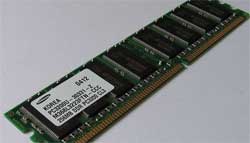Difference Between SDRAM and DDR
 SDRAM vs DDR
SDRAM vs DDR
SDRAM stands for Synchronous Dynamic Random Access Memory which is the commonly used memory before DDR (Double Data Rate) was released; after the release of DDR it became known as Single Data Rate SDRAM for differentiation purposes. It is clear with the terms DDR and SDR that DDR memory does something double of what SDR does and this is not necessarily the speed. The difference is in how the number of times data is transmitted in each clock cycle. SDR only does it once per clock cycle while DDR does it twice; a method that has come to be known as double pumping.
A clock cycle is used by computer parts as a signal to receive and send data. SDR also uses it and sends a certain amount of data per clock cycle. DDR takes advantage of the fact that a clock cycle has two significant parts, the leading edge and the trailing edge. Instead of sending just once per clock cycle, DDR sends data during the leading edge and does it again at the trailing edge doubling the amount of data it can send.
This simple design change allowed DDR memory modules to double the amount of data it delivers without changing the internal clock of the memory. This is very significant since in order to produce memory with much higher clock speeds, you need to obtain the purest silicon, which raises the total price of the memory module. This also meant that DDR chips that achieve identical performance to SDR chips are much cheaper in price.
DDR memory modules have also been designed to consume less power compared to the older SDR. Instead of the usual 3.3V that is used by SDRAM, DDR modules can operate at only 2.6V. This meant that DDR modules also create less heat compare to SDRAM. The advent of DDR made SDR memory obsolete and there are only a handful of computers that are using SDR as of today. Though the DDR is already an old technology, there are improved version of it called DDR2 and DDR3 which yields much faster speeds compared to DDR.
Summary:
1. SDRAM sends a word of data once per clock cycle while DDR sends data twice per clock cycle.
2. DDR can achieve significantly faster data speeds than a similarly clocked SDRAM.
3. DDR became cheaper than SDRAM.
4. DDR uses less power than SDRAM.
5. DDR produces less heat than SDRAM.
6. SDR-SDRAM is obsolete.
7. DDR is already old but its successors, the DDR2 and DDR3, are already taking over.
- Difference Between Sony Cybershot S Series and W Series - December 22, 2012
- Difference Between Samsung Galaxy S3 and iPhone 5 - December 21, 2012
- Difference Between Samsung Galaxy S2 (Galaxy S II) and Galaxy S 4G - December 20, 2012

Thank you sooooooo much 4d information.
May God bless U real goooooooooooooooood.
Wooow this is an awesome content
ur site rooooooooooooccccccccccccccckkkkkkkkks……….
Very useful thanks